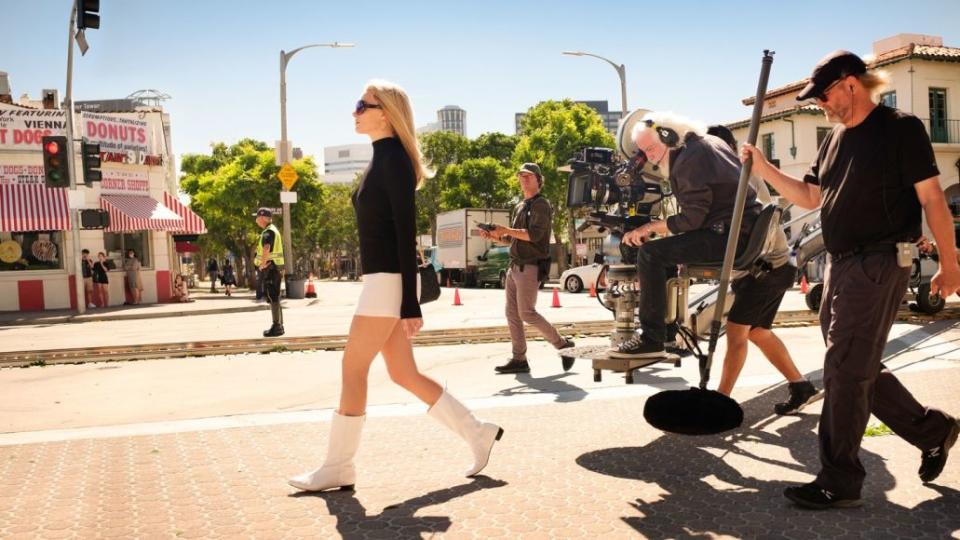A Definitive Ranking of Quentin Tarantino’s Films
- Oops!Something went wrong.Please try again later.
- Oops!Something went wrong.Please try again later.
- Oops!Something went wrong.Please try again later.
The post A Definitive Ranking of Quentin Tarantino’s Films appeared first on Consequence.
Welcome to Dissected, where we disassemble a band’s catalog, a director’s filmography, or some other critical pop-culture collection in the abstract. It’s exact science by way of a few beers. The time, we enter the quirky, warmhearted world of Wes Anderson. This article was originally published in 2018 and has been updated.
It’s fun to look back at Quentin Tarantino’s trajectory over the course of 20-plus years helming films. Once hailed as the video store punk with a proclivity for pop culture, Tarantino was the darling of Sundance in 1992 and quickly made a name for himself.
He was the motor-mouth with a subversive wit, killer soundtracks, and a love for comics, rockabilly, and creative uses of camp, and he spawned a whole lot of junky crime capers, not to mention a ton of snarky banter about indie filmmaking in the ‘90s.
Fast-forward to now: He’s mix-master maestro, the director as DJ, and one of the most exciting filmmakers today. He’s made an art of reinventing genres as postmodern tomes, turning dusty old logs from westerns, ninja films, and war flicks into rip-roaring spectacles.

For the release of his ninth feature Once Upon a Time… in Hollywood, Consequence of Sound decided to take a hot minute to thumb through old Tarantino flicks and rank the mad movie-maker’s filmography. Directorial only.
That means none of his CSI episodes, or that ER episode, or his scripts for True Romance or From Dusk Till Dawn. Just the directing credits, man. So. Like. Imagine this piece coming together in the spirit of Reservoir Dogs.
…
Ext. OPEN STREET – DAY
Five dudes in thrifty, black suits walk toward the frame, laptops and Blu-Rays in hand. Esoteric Ennio Morricone pulsates over the scene. Blake Goble is MR. PURPLE. Randall Colburn is CANDY COLBURN. Dan Caffrey is DJANIEL. Dominick Suzanne-Mayer is NOT-THE-BRIDE. And joining them to the left is Michael Roffman as RICK ROFFMAN.
SUPER: Ranking: Every Quentin Tarantino Film From Worst to Best
— Blake “Mr. Purple” Goble
10. Death Proof (2007)
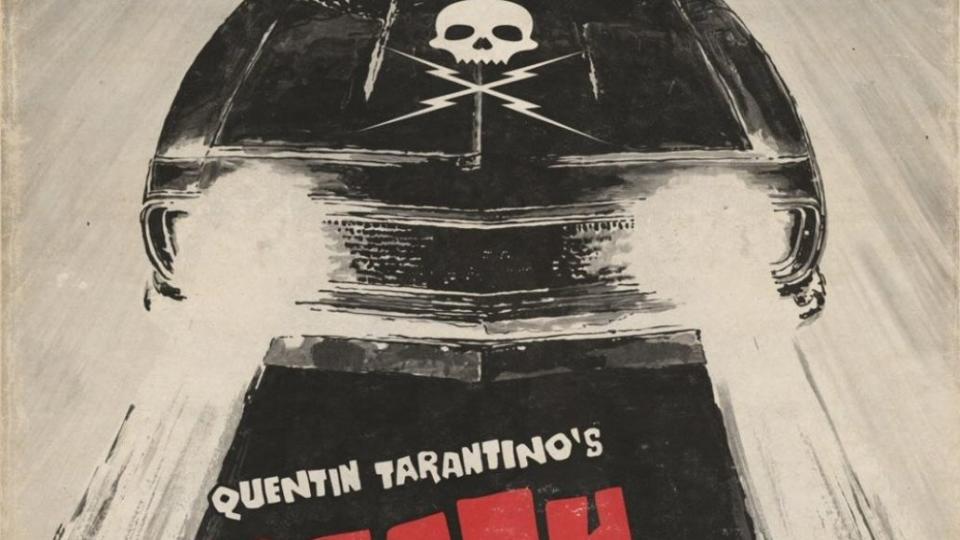
Runtime: 1 hr. 54 min.
Pitch: It’s a lurid, sweating world where beautiful women drink, smoke, and have extensive conversations about the most Tarantino subjects possible: sex, arcane pop music relics of the ‘60s and ‘70s, muscle cars. But in the night, Stuntman Mike sets out on the prowl for unsuspecting women that he can lure into his death-proof car. Well, at least it’s death-proof for him.
Cast: Kurt Russell, Rosario Dawson, Zoë Bell, Tracie Thoms, Rose McGowan, Mary Elizabeth Winstead, Vanessa Ferlito, and Jordan Ladd
T Gonna T (Quintessential Tarantino Moment): Let’s table that the first shot of the film tracks a comely pair of female feet, because it’s just too easy. And let’s move on to the point at which Russell seduces a much younger woman by reciting Robert Frost’s “Stopping by Woods on a Snowy Evening” in a dive bar, the result of a prank pulled by her friends involving an AM radio talk show. It’s the definition of self-aware indulgence, and rarely has Tarantino ever juxtaposed the eloquent with the filthy in such stark terms.
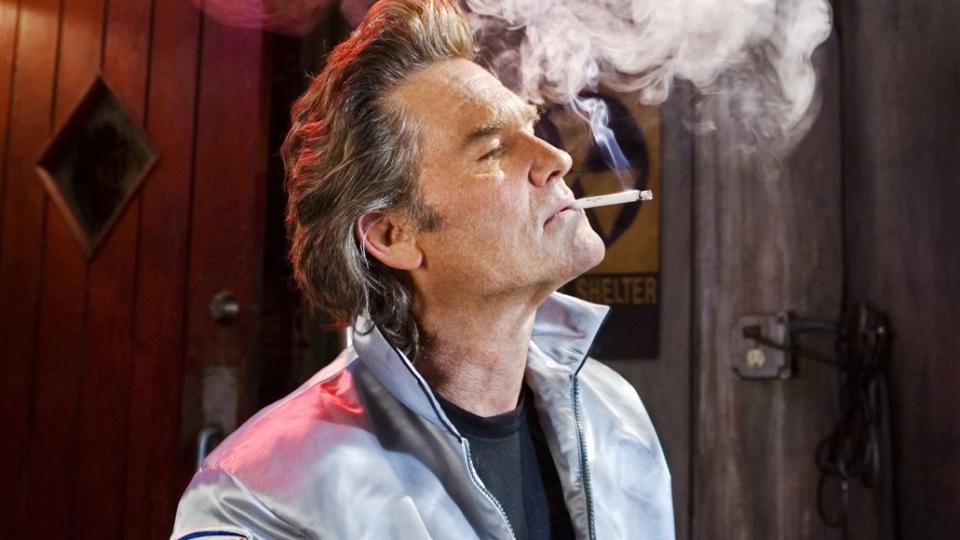
The Revival (Career Resurgence): Death Proof doesn’t really get enough credit for helping to usher in the more recent Kurt Russell, the one who showed up earlier this year in Furious 7 to actually turn and wink at the camera. Here Russell gets to take full advantage of Tarantino’s love for playing on the star personae of name actors and sinks his teeth into the entire ham from the second he shows up. Also, this movie fully made Zoë Bell’s career as a performer, after she served as Uma Thurman’s stunt double in Kill Bill. She went on to star in no shortage of her own grindhouse movies after this.
The Master Himself (Tarantino Cameo): Tarantino shows up as Warren, the owner of the seedy bar that serves as the center of the universe for the film’s first act.
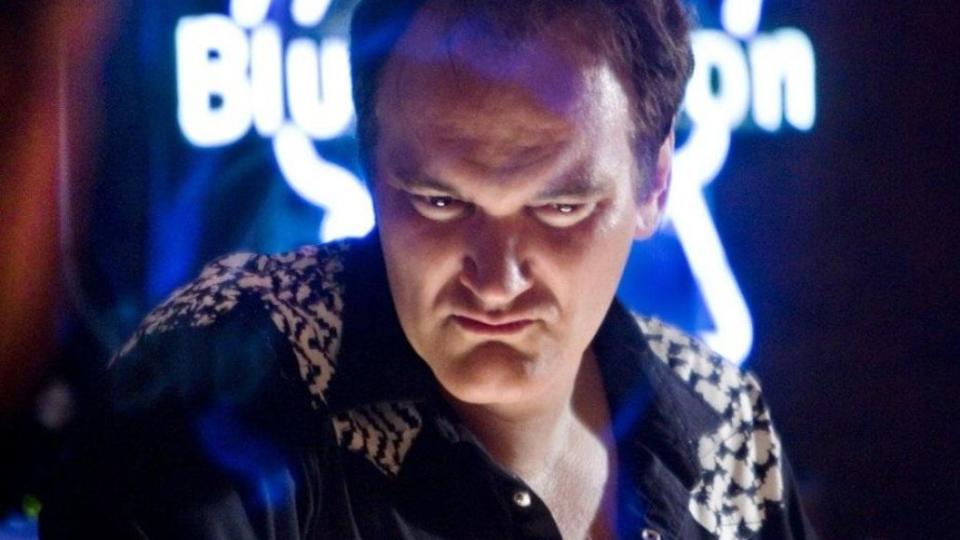
A pair of familiar faces: Notice Eli Roth and Omar Doom showing up early in the film as patrons. This was more than likely around the same time that the pair was cast in Inglorious Basterds as the young men who would kill Hitler. From such humble beginnings.
On Grindhouse: For those who may not recall, or the vast majority of you who didn’t see it in theaters, Death Proof was half of the release of Grindhouse, Tarantino and Robert Rodriguez’s attempt to revive the sleazy ‘70s drive-in experience in modern multiplexes in 2007.
The pacing of the films was only the beginning of the problems with selling such a thing to a broad audience; likely because of Tarantino’s standing as the more well-regarded filmmaker, the slow-burn crescendo of Death Proof played after the warp-speed throwback gorefest Planet Terror. And it just did not work.
Also: Grindhouse was a delight, and it’s genuinely sad that the experiment won’t live on. No, the Machetes don’t really count.
Analysis: Okay. So Death Proof isn’t Tarantino’s best film. More accurately, there’s a pretty huge uptick in quality of the films on this list immediately following Death Proof. While Tarantino’s fullest-ever immersion in cheap, easy drive-in trash has its moments, as one could expect of a master filmmaker cutting loose within one of his own pet media, it’s unwieldy to say the least. Death Proof is so self-aware of its own slavish adherence to every trope of the medium that at times it gets just as lurid and nasty as its predecessors, particularly around the time that Winstead’s perpetual cheerleader is abandoned by her friends for an implied rape joke that sits worse when it becomes clear the film has no plans of cycling back to her.
But with all this said, and accepting it’s the least of his works, the chase scene that occupies most of the film’s final third is some of the director’s best filmmaking on its own. It moves at breakneck speeds, the actual stuntwork used to pull it off is so tangible on the screen that it makes the film both exhilarating and utterly alarming, and the payoff at its end is so darkly funny and satisfying that it nearly pulls off the trick of justifying everything that comes before it. Nearly.
— Dominick Suzanne-Mayer
09. The Hateful Eight (2015)
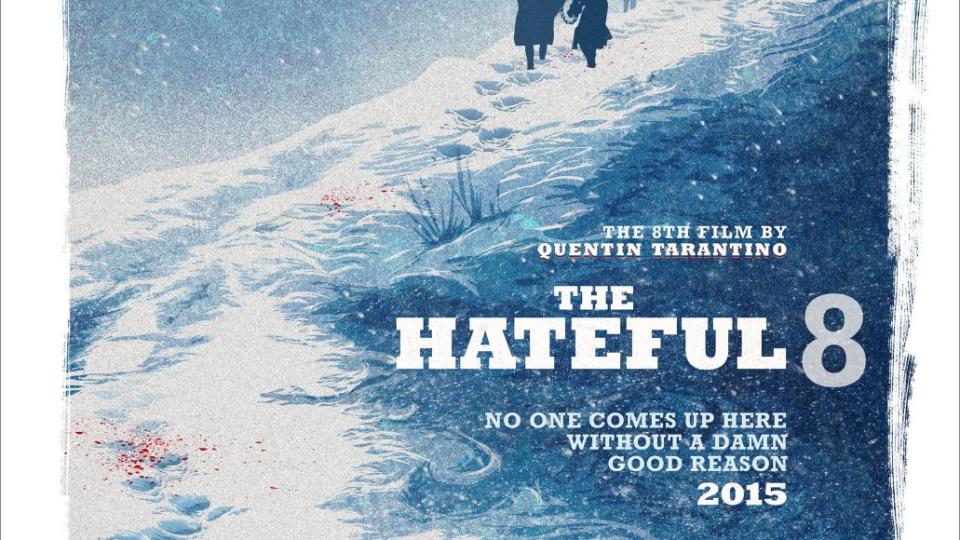
Runtime: 3 hr. 7 min. (Roadshow version); 2 hr. 47 min. (General version)
Pitch: Making its way through the snow-blanketed mountains of Wyoming, a stagecoach carries two bounty hunters, a captured criminal, and a man claiming to be a sheriff. When a blizzard forces them all to seek refuge at a general store called Minnie’s Haberdashery, they encounter four more rugged individuals who appear to be strangers. Of course, this is a Quentin Tarantino film, and the eight roughnecks may be more connected than anyone realizes, forming a tense, bloody thriller that’s half backwoods Western and half Agatha Christie.
Cast: Samuel L. Jackson, Kurt Russell, Jennifer Jason Leigh, Walton Goggins, Demián Bichir, Tim Roth, Michael Madsen, and Bruce Dern
T Gonna T: Once everyone’s holed up in the misleadingly titled haberdashery, it becomes clear that the bar scene from Inglourious Basterds was just a warm-up for The Hateful Eight. Although QT builds tension through the same types of secret histories, subtle looks, and unspoken malice in both films, his latest outing boils over two hours rather than 30 minutes. Don’t be surprised if your fingernails are gone by the time the credits roll.
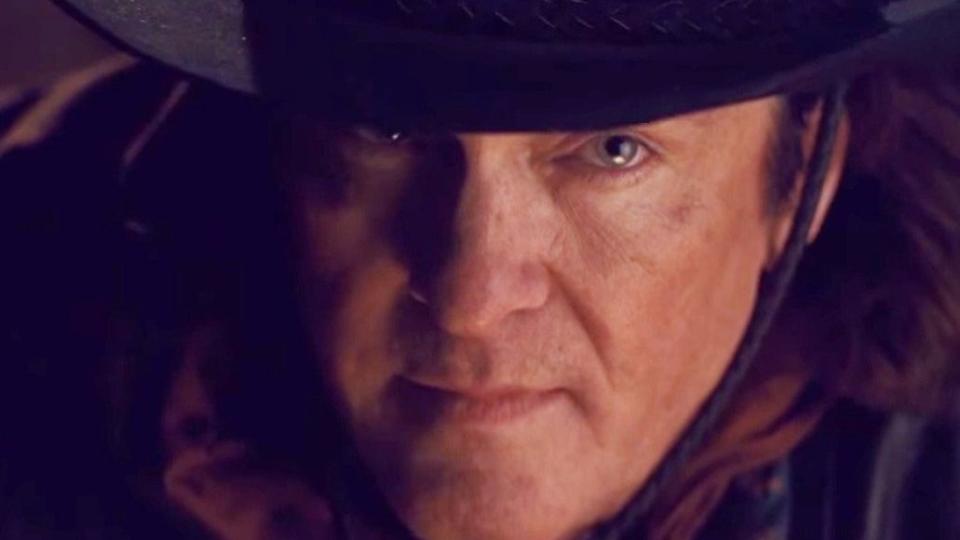
The Revival: Every one of the main actors here (and even some of the bit parts) is an A-lister in no need of a career revival. Even Demián Bichir, the sole cast member I had to look up, is an Oscar nominee. We’ll go with Michael Madsen, though.
The Master Himself: We can’t speak for the film’s standard version, but anyone seeing the extended “Roadshow” edition of The Hateful Eight in 70mm is welcomed back after intermission by a voiceover from QT himself. Don’t get too excited — it’s the weakest part of the movie, another moment where Tarantino can’t resist winking at the audience. That’s fair enough in and of itself. After all, the guy did create the thing. But at the end of the day, the script isn’t complicated enough to suddenly warrant a narrator; he should learn to trust in his own visuals.
The Play’s the Thing: It’s no surprise that The Hateful Eight has origins as a staged reading, as it often feels more like a short play than a film. Outside of the stagecoach journey, there’s only one location (the Haberdashery), and the entire cast — bit parts and all — totals only 18 actors. Maybe we’ll see an adaptation go up at an Off-Broadway blackbox sometime in the next few years.
Once Upon a Time in the ’80s: When Tarantino revealed that dynamically weathered composer Ennio Morricone would be scoring his first Western since 1981 with The Hateful Eight, you could almost hear the music right then and there: prairie harmonica, clomping guitar, maybe a theme for each character. Yet despite working in his most famous genre, Morricone bucks the traditions he created in favor of more ominous drones reminiscent of his work on The Thing. The menacing sonics make sense when you consider the film’s tightly wound violence, and the fact that, while The Hateful Eight may be a Western, it’s not a spaghetti Western.
Analysis: The more you know about The Hateful Eight, the less you’re going to enjoy it. Just understand that it mixes the best parts of the picturesque Western (think Huston and Ford, not Leone and Carbucci) with the best parts of a murder mystery (see: the aforementioned Christie reference). And like most things Tarantino, the film breaks out of these genre trappings by leaning on a thematically rich plot device: having all of its characters be directly affected by the Civil War. The still-boiling regional and racial strife makes allies seem less trustworthy, enemies seem more friendly, and every person capable of terrible acts.
— Dan Caffrey
08. Kill Bill Vol. 2 (2004)
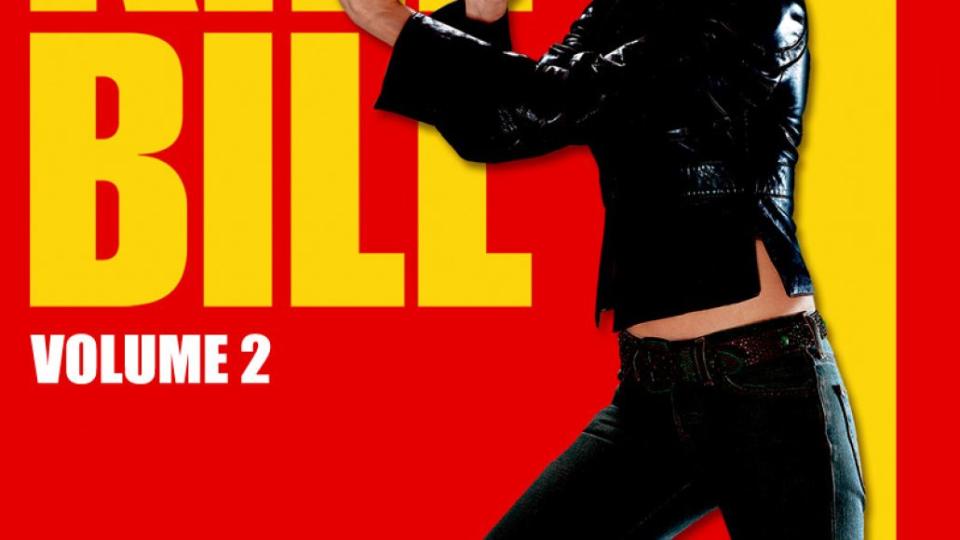
Runtime: 2 hr. 17 min.
Pitch: Picking up right where the first Kill Bill film leaves off, The Bride sets out to finish off the rest of the Deadly Viper Assassination Squad en route to Bill, the man who killed her. Only he didn’t. And there’s the matter of him having the Bride’s daughter under his roof, a daughter she believed she’d lost.
Cast: Uma Thurman, David Carradine, Daryl Hannah, Michael Madsen, Gordon Liu, Michael Parks, Perla Haney-Jardine, and Samuel L. Jackson
T Gonna T: When it comes to the Kill Bill films, everything happening onscreen at virtually any time is peak Tarantino. But it’s the moment when The Bride is buried alive that sets off a solid 20-30 minutes of quintessentially QT cinema. Setting aside that the film leaves its protagonist to die and then takes that opportunity to stage a lengthy digression about her tutelage in the mountains, there’s also the nightmarish shot of a pepper spray nozzle in extreme close-up, the claustrophobic terror of her mad scramble inside the grave, and the suddenly oversaturated, grindhouse-quality photography of the entire Pai Mei sequence itself. By the time she claws her way back to the world of the living, to the tune of Ennio Morricone’s “L’arena” no less, you can practically hear the director cackling with glee.

The Revival: During the late-game diner conversation in Pulp Fiction, Samuel L. Jackson expresses his desire to “walk the Earth, like Caine in Kung Fu.” So it makes sense that about a decade later, Tarantino would cast Caine himself, David Carradine, as the pursued Bill. And just to drive the point home about some of his other beloved genre stars, Gordon Liu and Michael Parks both get to play different roles than in Vol. 1; Liu is the vicious but skilled Pai Mei, who once gave The Bride the training she needs to eventually punch her way out of an early grave, and Parks shows up as Esteban Vihaio, the gentleman pimp who gives The Bride her essential final clue to finding Bill.
The Master Himself: Vol. 2 is actually the only Tarantino film to date in which the filmmaker doesn’t appear in some way, onscreen or otherwise. Sure, if you take the Bills as one movie, he’s elsewhere, but more on that later.
The Killing Strike: Vol. 2 isn’t the first film where the Five Point Palm Exploding Heart Technique has popped up. The Shaw Brothers’ Clan of the White Lotus and Executioners of Shaolin both address this method of disposing of one’s enemies as well. It’s unclear whether or not dim mak is actually real, but it makes for one hell of a film ending.
Film Bros: That version of “Malagueña” that plays over the film’s curtain-call end credits? It’s by Chingon, the Texas band featuring Tarantino’s longtime filmmaking bestie Robert Rodriguez. Rodriguez was also responsible for a good bit of the score in Vol. 2 as well.
Analysis: Because of the nature of Kill Bill’s dual structure, it’s difficult at points to not take Vol. 2 as a comedown from the film’s giddy first half. It’s not an inherently bad thing, and it may well make the case for the films as better as disparate halves. (Though having that argument, the second part absolutely works better as a standalone than the first by that metric.) Vol. 2 is Tarantino’s first real overture into the sort of grandiose, operatic, frequently 70mm filmmaking that he’s always called the biggest influence on his own work.
It also casts into sharp relief the one topic Tarantino has never explored in any truly deep way as a filmmaker: love. Vol. 2 is romantic cinema not only in its often opulent production, but in its realization that a four-plus-hour bloodbath about revenge can end in a conversation of searing revelations. (Its closest kindred spirit would be Django Unchained, but even that film ends on the burning plantation house and not on the couple merrily riding away.) The Kill Bill story doesn’t end in a way that really answers to The Bride so much as what made her.
Ultimately, it’s a saga about Beatrix and Bill and the doomed love they once had. And for his only real foray into that particularly well-trodden narrative realm, Tarantino understands that sometimes, underneath all the cool battles and the elaborate death threats, there’s just a lot of broken hearts. It’s as honest a way to end an action movie as the director will ever land upon.
— D.S.M.
07. Reservoir Dogs (1992)
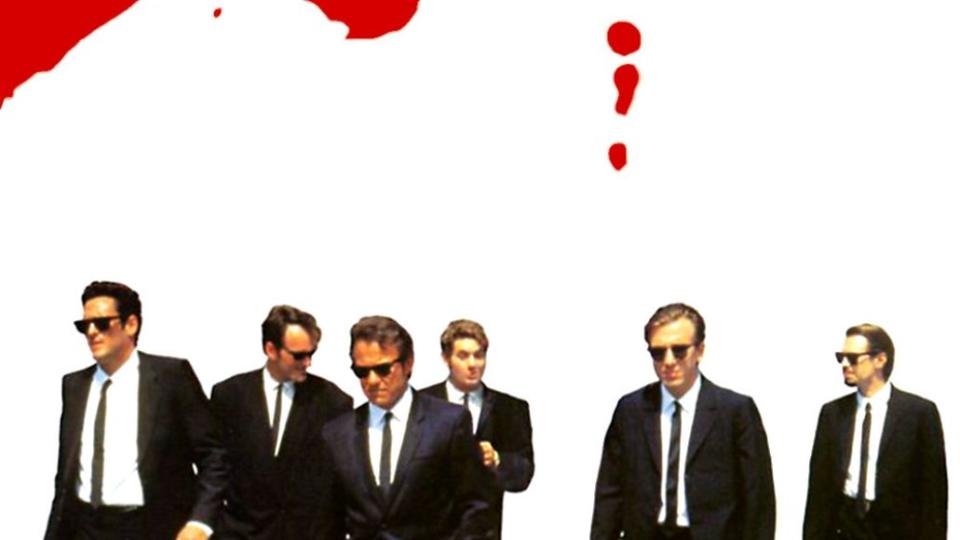
Runtime: 1 hr. 39 min.
Pitch: Six criminals with color-coded names execute a diamond heist for crime boss Joe Cabot, but something goes awry and everyone smells a rat. The surviving crooks convene at their rendezvous location, where each tries to figure out who’s not on the level.
Cast: Harvey Keitel, Tim Roth, Michael Madsen, Steve Buscemi, Lawrence Tierney, Chris Penn, Eddie Bunker, and Quentin Tarantino
T Gonna T: Tarantino lives and dies by his influences, yet has that unique ability to spin gold from faded celluloid. Take the iconic opening stroll that heralds Reservoir Dogs’ opening credits: the cool, grinning confidence evokes Kiss of Death’s terrifying Tommy Udo, the tableau is a clear reference to the droogs in A Clockwork Orange, and the matching suits are John Woo through and through. The simplicity with which he blends these elements, and the ingenuity he shows through both his use of slow-motion and choice of ‘70s pop – George Baker Selection’s “Little Green Bag” – creates an aura that’s as inviting as it is ominous. There’s a reason it’s one of the most memorable opening credit sequences of all time.
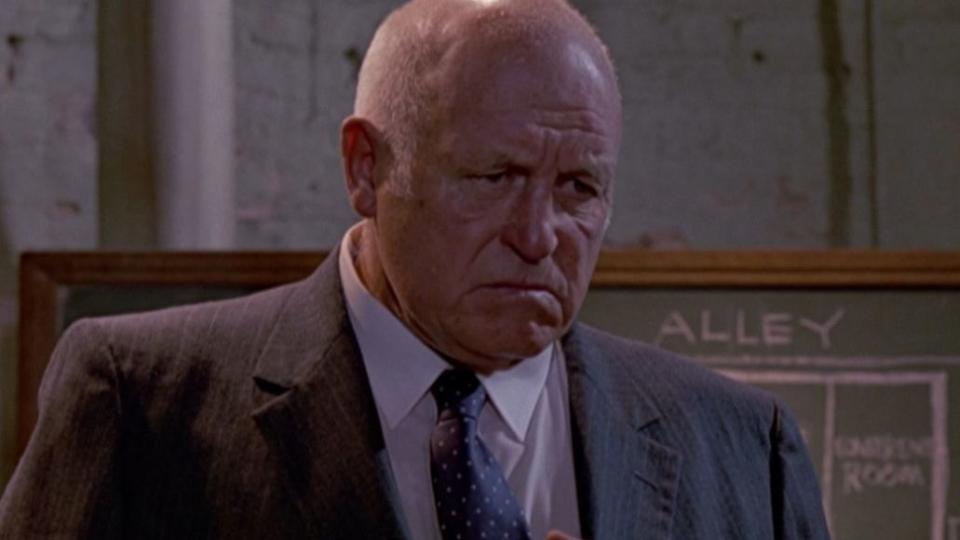
The Revival: Tarantino didn’t bring any actors back from the dead with Reservoir Dogs, though, along with 1992’s Bad Lieutenant, he certainly helped remind people of Harvey Keitel’s talent for playing vulnerable, complicated crooks. His biggest piece of throwback casting was probably Lawrence Tierney, the gravel-voiced brute who memorably played the title character in 1945’s Dillinger. Tarantino actually wrote the role of Cabot for his hero Timothy Carey, another imposing heavy who made a name for himself in genre fare like Stanley Kubrick’s The Killing and John Cassavetes’ The Killing of a Chinese Bookie, but Carey was apparently just a touch too unpredictable for the first-time director. Tarantino, instead, included him among the film’s dedications.
The Master Himself: Tarantino, mugging it up like this were a community theater production, looks like he’s having the time of his life as Mr. Brown, the ill-fated getaway driver. He’s less of a character, really, than a manifestation of his own singular energy. More below…
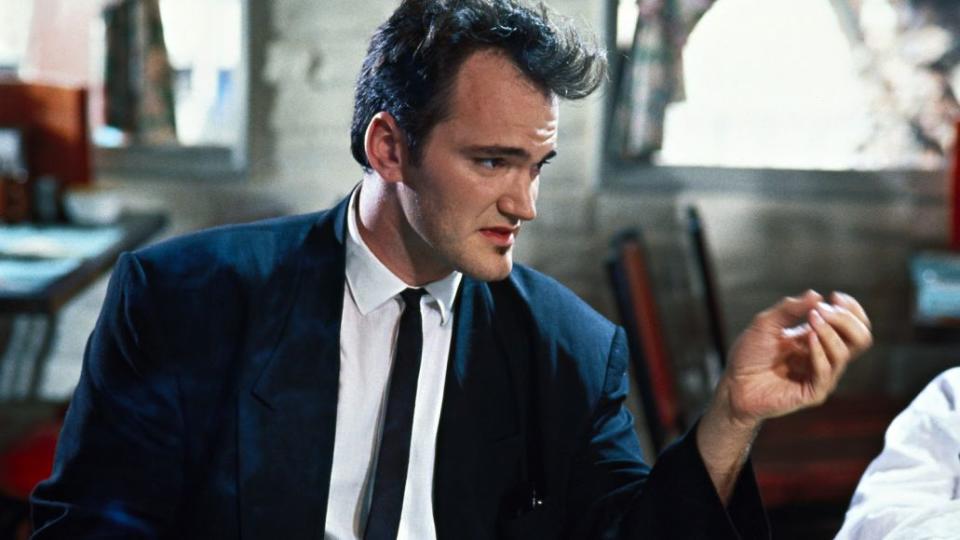
Pop Goes the Culture: Nobody talks about pop culture like Tarantino. His appetite for movies, music, books, and comics isn’t just a quirk of his character, but in so many ways the driving force behind his aesthetic. Casting himself in Reservoir Dogs to give a lengthy monologue about Madonna’s “Like a Virgin” could be read as a vanity move, but it registers more as an introduction of sorts. He’s not gonna kick off his hard-boiled crime drama with a splash of blood, but rather a carefree breakfast where we can see these criminals talk like human beings – what other heist flick would introduce the rugged, ruddy-faced Eddie Bunker by having him proclaim his love for Madonna’s True Blue?
K-Billy’s Super Sounds of the ’70s: Setting a torture sequence to music was an idea Tarantino pilfered from Joseph Lewis’ 1955 crime film The Big Combo, but his greatest moment of inspiration was choosing a song as upbeat and catchy as Stealers Wheel’s 1972 ditty “Stuck in the Middle with You”. It’s a trick Tarantino uses throughout the whole movie, as nearly the entire film is soundtracked by K-Billy’s Super Sounds of the ‘70s, a radio program specializing in the bright, sunny pop hits of that kaleidoscopic era. There’s no eerie synths or orchestral drones here. Just pop.
Analysis: Tarantino pulled a Shakespeare with Reservoir Dogs. He took a story that’s been told a dozen times before – almost beat-for-beat in Ringo Lam’s 1987 Hong Kong heist film City on Fire – and elevated it with the artistry of his vision and the talent of his execution. It’s not the story that asserts itself; it’s everything from the dialogue and character designs to the cinematography and use of violence. Shakespeare wasn’t remembered for the ingenuity of his stories, but what he could accomplish within the confines of one. Tarantino could’ve filmed “The Itsy Bitsy Spider” and still made a splash.
Reservoir Dogs is packed with all the influences, nods, and Easter eggs that people love to dissect when they’re discussing Tarantino, but by virtue of it being his first film, it feels less like an event and more like, well, a movie. By this, I mean to say that the Tarantino style, as it’s developed, is one that’s encompassing – every exchange, action sequence, or act of violence is simultaneously hilarious, ominous, and upsetting. Reservoir Dogs is less layered, as Tarantino was clearly still honing his sense of humor.
There’s lots of great dialogue in Reservoir Dogs, but there’s no sick joy in watching Mr. Blonde slash Nash’s face with a straight razor or Mr. White mow down a car full of cops. It’s ugly, really, a word you’d be hard-pressed to apply to any of Tarantino’s other works, which tend to temper the violence with a sheen of surprise, irony, and winkiness. Still, Reservoir Dogs is stunning, an ode to the heist films of yesteryear that, 23 years later, still feels thoroughly modern.
— Randall Colburn
06. Kill Bill Vol. 1 (2003)

Runtime: 1 hr. 52 min.
Pitch: The Bride was about to get married, but was then betrayed by the band of assassins she called kin and shot execution style while pregnant on her wedding day. When she wakes up from the resulting coma years later, the revenge-minded bloodshed starts in the hospital room and ends in a second, separate movie. This is the first five chapters of a 10-chapter story.
Cast: Uma Thurman, Lucy Liu, Vivica A. Fox, Sonny Chiba, Julie Dreyfus, Chiaki Kuriyama, and Michael Bowen
T Gonna T: It wouldn’t be much of a stretch to imagine that the film’s instantly iconic, controversial “House of Blue Leaves” sequence is what the inside of the filmmaker’s head looks like on a given day. It’s beautifully shot, drapes its entire set in Argento Reds as The Bride lays waste to seemingly all but one of the Crazy 88 (the last is let off with a spanking) and literally opens a door from one genre into another, right around the time that the film follows The Bride from the ‘70s wuxia interiors of the restaurant to the snowy, classical Japanese garden outside. Eventually, that ends up covered in blood as well, but it’s still the best illustration of the film’s many influences both high and lowbrow.

The Revival: The standout here is longtime Japanese star Sonny Chiba as Hattori Hanzo, the legendary swordsmith who emerges from a self-imposed retirement to fashion one more sword with which The Bride can exact her vengeance. Obligatory, because it’s one of Tarantino’s best-ever lines: “This is my finest sword. If on your journey you should encounter God, God will be cut.” While Chiba is best remembered stateside for The Storm Riders or The Street Fighter, the absurdly prolific Toei mainstay has been active in pushing the form of the martial arts movie forward for decades, as both actor and filmmaker.
The Master Himself: He’s one of the many casualties the Crazy 88 suffer during their ill-fated attempt to stop The Bride from her appointed rounds. It’s one of his more innocuous appearances in his own films.
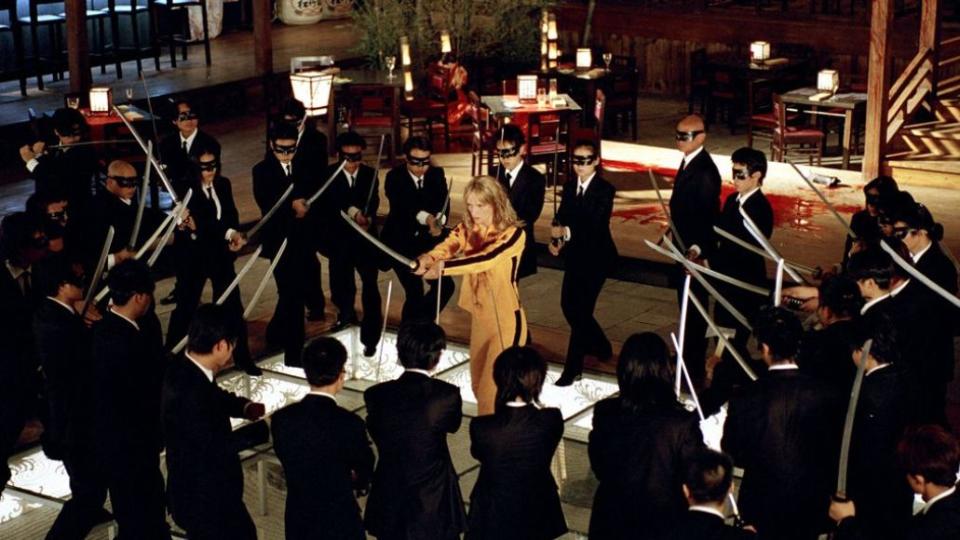
Kill again? For years, Tarantino has publicly mulled over the idea of a third Kill Bill film (which would have to be called Kill Beatrix, right?), but has made no moves. While it’s frustrating given the film’s perfect setup, which as he puts it would cast Nikki, Vernita Green’s daughter who has to witness her mother’s death firsthand in Vol. 1, on her own cyclical journey of revenge against her mother’s killer, it only speaks to its director’s habit of lingering on projects for years before returning to them or wholly discarding them. As of now, it’s probably not happening, but then The Hateful Eight was supposed to be scrapped after its script leaked, and now it’ll be in theaters at the end of this week. Who knows?
“Now would be the time to say it”: If you watched the film and noticed that Chinese actress Lucy Liu was playing a Yakuza boss, a Japanese tradition, well, that was on purpose. The actress’ heritage was written into O-Ren’s character upon her casting and ends up changing quite a bit about her interactions with the fellow bosses.
Analysis: Vol. 1 is wildly entertaining as its own standalone film. If anything, it’s the purest distillation of his grindhouse urges into a still-effective film (see: Death Proof for the inverse). While the film’s emotional core isn’t really established, Tarantino simply gets to flex his abilities to jump from one genre to the next by the chapter and to zealously recreate the visceral thrills of each.
It’s Tarantino at his film geekiest, evidenced in everything from Chiba’s appearance as a sort of deity handing a sword to Tarantino’s own chosen protagonist to the employment of the RZA, himself an avid enthusiast of the martial arts subgenre, to assemble the film’s kicky, anachronistic soundtrack.
It’s also some of the most thrilling cinema he’s made. Given the nature of the two-part movie, he’s able to linger on scenes that might not make it through the final pass of a single movie, such as the playful banter between O-Ren and The Bride before their showdown or the triumphant urgency of The Bride’s hospital escape. (“Wiggle your big toe.”) It’s a bloody, breathless action film that still gets to take the time to indulge in all the little side interests and digressions that characterize so much of the director’s work. Best of all worlds, really.
— D.S.M.
05. Once Upon a Time in.. Hollywood (2019)

Runtime: 2 hr. 41 min.
Pitch: It’s 1969 in Los Angeles. The sun is out. The stars are beaming. But there’s change in the air. Facing those tailwinds is Rick Dalton, an aging talent who’s contending with a future that may not belong to him; his trusty stuntman Cliff Booth, whose behind-the-scenes wizardry may also be heading for the hills; and rising icon Sharon Tate, whose permeable lifestyle involves danger that dwells beyond the silver screen.
Cast: Leonardo DiCaprio, Brad Pitt, Margot Robbie, Emile Hirsch, Margaret Qualley, Timothy Olyphant, Al Pacino
T Gonna T: When Sharon Tate stops in to the Bruin Theatre to see herself in The Wrecking Crew, you can almost catch a reflection of Tarantino grinning in the film’s framed poster outside. Like Tate, he’s reveling in the moment, not only for the magic of the theatergoing experience, but the time itself.
It’s telling in the way he amiably cuts back and forth from the screen to Tate’s bedazzled reactions. He’s like McFly with a Delorean, trying his damnedest to soak up the moment by relishing all the nitty, bitty details, from the hammy trailer for biker joint CC and Company to the specific Wrecking scenes that Tate mimics with charming delight … and, naturally, to her feet.
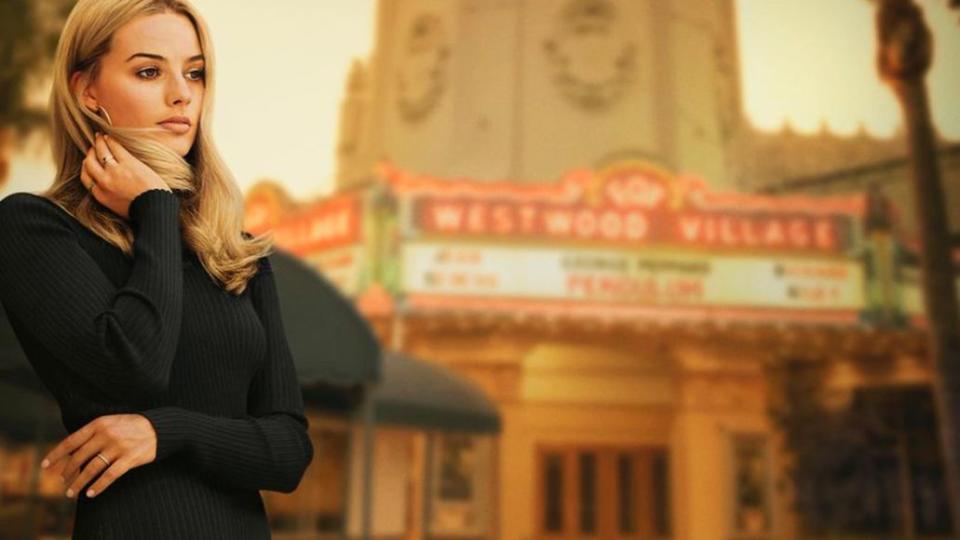
The Revival: Christ, take your pick. There’s the troubled Emile Hirsch playing Tate’s lovable hairstylist Jay Sebring. We haven’t seen him in awhile. The late Luke Perry pops up for a minor bit as Wayne Maunder. Spencer Garrett offers a humble take on a fictional TV personality in Allen Kincaid. Hell, even Cobra Kai sensei Martin Kove cuts the screen as a Bounty Law villain. Blink and you’ll miss a fringe celeb doing their thing.
The Master Himself: Hard to say. On a first run through the film, the guy’s nowhere to be seen — and that’s probably wise, especially after that narration from The Hateful Eight — but it’s possible he’s lingering somewhere in the background. Maybe at Spahn Ranch. Or better yet, the Playboy Mansion, where everyone’s frolicking around. Of course, you’ll have to look past Damian Lewis’ distracting cameo as Steve McQueen.
California Dreaming: Kudos to production designer Barbara Ling for her stylish recreation of ’60s Hollywood. Given the tumultuous times, and the expansive nature of this story (not to mention the scope of the whole goddamn thing), it would be nigh-impossible to actually capture the era in full and to perfection.
Yet Tarantino and Ling bring justice to the proceedings by recreating a dizzying array of vintage settings that feel lived-in. What’s more, they’re all practical. They’re all physical. And they’re never too glossy. Unlike so many winded trips back in time, Tarantino actually did his fucking homework, and his attention to detail, and the fact that he revisited so many past haunts, only embellishes the idea that this is a “love letter” to the city and the times.
Hurdy Gurdy Man: Don’t expect to see much of ol’ Charlie Manson. Although Tarantino cast creepy lookalike Damon Herriman as the late cult leader, he only makes a minor appearance. It’s an eerie one, though, and while Herriman never appears again, his presence is felt. Sincerely.
Like The Shape in John Carpenter’s Halloween, Manson’s influence thrives in the corners of the film. He’s a crusty menace that often punctures the sun-soaked serenity that everyone’s shuffling under. It’s a smart move on Tarantino’s behalf, and certainly a pointed one, especially when the film comes to blows at the end. We won’t spoil anything, but know that Tarantino is hardly a fan of the “Family.”
Analysis: Tarantino’s working through something with Once Upon a Time… in Hollywood. It’s not a crisis, per se, but it’s an evaluation of sorts. There’s admittedly a strange connection going on between the freewheelin’ times of yesteryear and the trouble ahead today for Hollywood. Think about it: Tarantino is an anomaly in 2019. He’s making events out of adult dramas at a time when adults aren’t a priority in the industry. Like DiCaprio’s Rick Dalton or even Pitt’s Cliff Booth, he’s contending with the fact that he may be old hat, a rusty gun, a forgotten relic.
But he’s not giving up. The fact that this film is Tarantino at his most tranquil suggests that the auteur has never been more comfortable. There’s a sagacious quality to the way he cruises through Hollywood that insists upon some kind of acceptance on his behalf. If anything, he’s indulging in the playgrounds he can still create, and the way he portrays the star-gazing Tate only embellishes that argument. Having said that, there’s an underlying bitterness that peeks through every so often, particularly in the end when he’s at his most vitriolic. But it’s never severe. It’s comical. Dreamy even.
This is Tarantino’s most poetic “What if?” yet.
— Michael Roffman
04. Inglorious Basterds (2009)

Runtime: 2 hr. 33 min.
Pitch: In this revisionist action-comedy-drama, a ravenous band of Jewish US soldiers – the Basterds – and a vengeful theater owner concoct plans to destroy the Third Reich from the top down.
Cast: Brad Pitt, Christoph Waltz, Mélanie Laurent, Diane Kruger, Michael Fassbender, Eli Roth, Daniel Brühl, and Til Schweiger
T Gonna T: That Tarantino managed to make concepts of film and fandom so integral to Inglourious Basterds, a WWII period piece, makes the film so distinctly of his oeuvre. The final showdown takes place during a film premiere, one of the leads owns a movie theater, another is a propaganda film star, and another soldier is recruited precisely because of his deep knowledge of German cinema.
Couple this unique focus with long, intimate scenes that take place not on the battlefield but in cramped tavern basements and you’ve got a war film that was made by someone whose tastes are much more cinematic than idealistic.
The Revival: It’s not a revival, necessarily, but with Inglourious Basterds Tarantino introduced American audiences to the beam of heavenly light that is Christoph Waltz. Before Inglourious Basterds, Waltz was a fairly successful fixture of British, German, and Swiss television and theater. He’s since racked up two Academy Awards for his Tarantino collaborations. If I were Waltz, I’d stay put. It’s also of note to mention that Inglourious Basterds is the only non-Shrek movie Mike Myers has acted in since his much-maligned The Love Guru. He’s great, too.
The Master Himself: You won’t see Tarantino’s face in Inglourious Basterds, but you will see his hands. When Waltz’s Hans Landa strangles Diane Kruger’s Bridget von Hammersmark, it’s actually Tarantino’s hands in the shot. “What I said to her was, I’m gonna just strangle you, alright? Full on, I’m gonna cut off your air, for just a little bit of time,” Tarantino said. “We’re gonna see the reaction in your face, and I’m gonna yell cut.”
…okay.
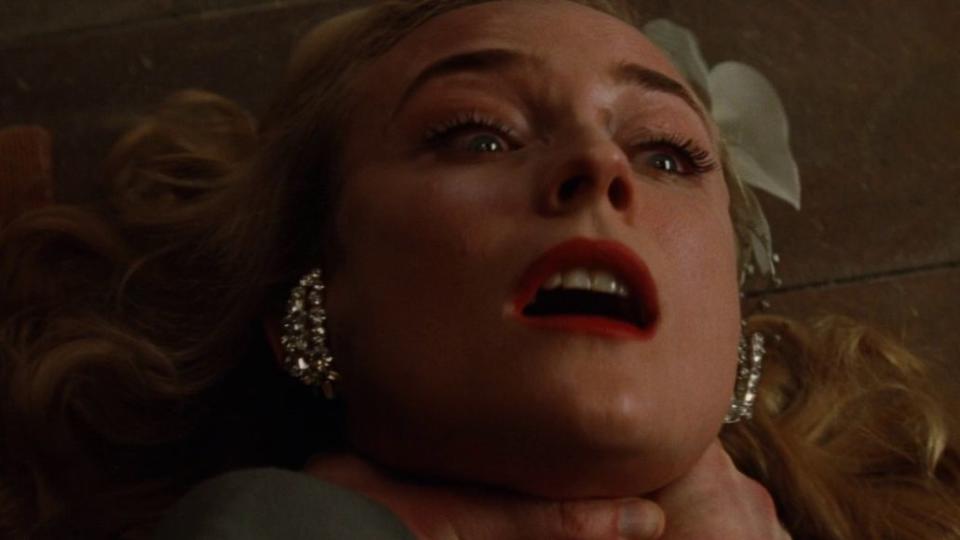
Hitlers on Film: Filmic depictions of Hitler have become more nuanced over time, especially in the numerous “in the bunker” films – Downfall, The Bunker, Liberation – that chronicle the dictator’s last days. Downfall, especially, was praised for its even, humanistic take. And then there’s the Hitler of Inglourious Basterds.
Played by German actor Martin Wuttke, this Hitler is a gross caricature, loud and hilariously childish, at one point even cackling at images of death as if it were a Yosemite Sam cartoon. This approach is much more in line with the films, skits, and cartoons of the ‘40s, however, when non-German movies relentlessly mocked Hitler, depicting him as a buffoonish maniac. The Three Stooges filmed several skits of this type, though Charlie Chaplin’s Adenoid Hynkel from the 1940 film The Great Dictator is probably best remembered.
That Title, Tho: “I’m never going to explain that,” Tarantino said of the film’s hilariously misspelled title. “When you do an artistic flourish like that, to describe it, to explain it, would just … invalidate the whole stroke in the first place.” He was badgered more and more, retorting with claims that it was a “a Basquiat-esque touch” and that “that’s just the way you say it: Basterds.”
Truly, there isn’t really anything to explain. Honestly, the title itself is indicative of the general milieu of the Basterds, a rough-and-tumble bunch of misfits who aren’t renowned for their intelligence or articulation but their fearlessness and brutality. They don’t give a fuck about proper spelling, and neither does this movie.
Analysis: Tarantino grew up on “men on a mission” war movies like The Guns of the Navarone, The Dirty Dozen, and Where Eagles Dare, but when it was time to make his own, he fortified his approach by indulging in an entirely different war sub-genre. Propaganda films of the 1940s, made in Hollywood by foreign directors living abroad, presented Tarantino with an altogether different approach to the war movie, one that centered more around action and humor than what Tarantino calls “the ponderous, anti-war, violin-music diatribes that we’ve seen in war movies since the ’80s.”
And Inglourious Basterds isn’t anti-war. It’s not pro-war, either. And that’s precisely why it works as well as it does. In a climate where we can’t make a war movie without it being so intensely about war, Tarantino made a hilarious one about revenge. It’s oddly intimate, really, this movie, focusing on individuals with an axe to grind. It’s not one’s country or humanity who gets revenge in this film, but the specific people who’ve lost someone. As big as Inglourious Basterds gets, it never zooms out so far that we lose sight of the hearts (and laughs) at the center of this story.
— R.C.
03. Django Unchained (2012)
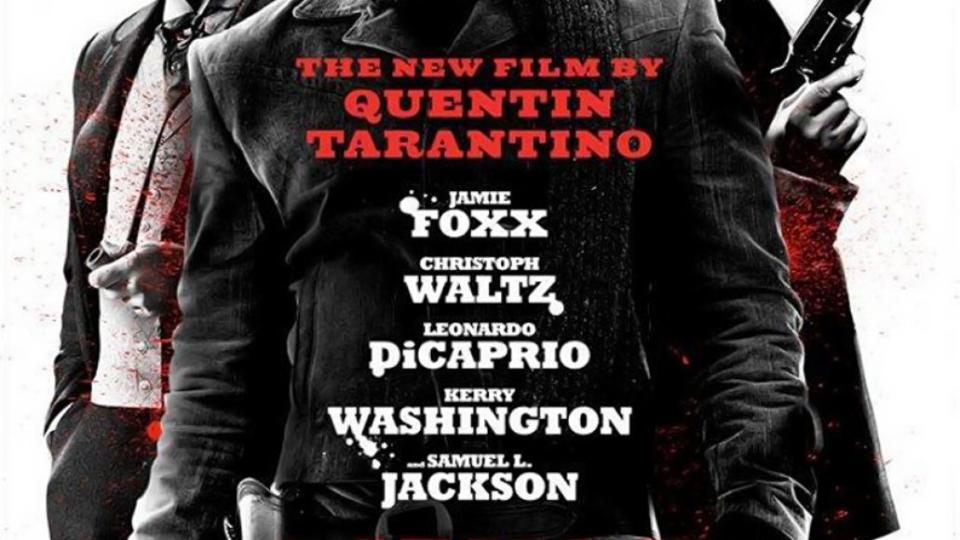
Runtime: 2 hr. 45 min.
Pitch: Django, a soulful, soft-spoken, and married slave is freed by a congenial, mysterious German bounty hunter and former dentist named King Schultz. Together, Django and Schultz form an uncommon friendship and embark on a cross-country tour of motivated mayhem, offing hillbilly slavers in giddy ways, while trying to find Django’s wife, Broomhilda.
Cast: Jamie Foxx, Christoph Waltz, Leonardo DiCaprio, Samuel L. Jackson, Kerry Washington, Jonah Hill, Don Johnson, and Walton Goggins
T Gonna T: Is there a more Tarantino moment in Django than when the scorned gunman and hero of the film pulls pistols and takes out an entire house of Southern slavers in slow, luxurious motion, while a mix of 2Pac and James Brown play in the background? Spoilers, probably? NSFW, too?
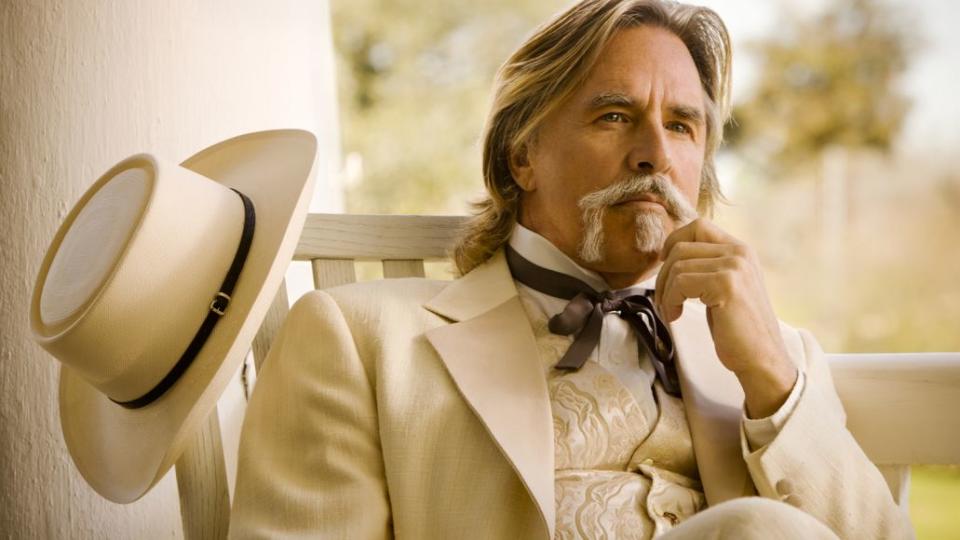
The Revival: Mr. Miami Vice, himself, Don Johnson. And he’s got one of the funniest lines in the movie. “Damn. I can’t see fuckin’ shit outta this thing!”
The Master Himself: Quentin’s Australian accent is less than Oz-some. Yet his cameo is totally worth it for this spoiler:
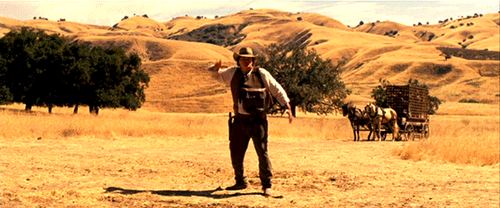
Candy to Tooth: When Django Unchained showed up on Christmas 2012, the movie was a nice, fat hit for QT, and leading up into awards season, DiCaprio, Oscar’s favorite flirt, was getting all the hype for his portrait as the yellow-toothed, hatefully bored boy prince Calvin Candy. He broke his hand on a glass for the film; that’s actorly stuff by way of Brando right there.
However, when the film came out, a curious twist happened in the Oscar race. Waltz started to pull away as the odds-on favorite with audiences and voters. His Schultz, a sympathetic, racially enlightened, and moral-yet-deadly killer played like gangbusters. It was an extremely affable part. The shift in award consideration was a curious awards twist, given that DiCaprio was the showy fave, but something about Waltz’s good-guy gunman struck a chord. It was like the antithesis to his Oscar-winning Nazi nastiness in Basterds.
Ennio a No Mo? After having his music utilized several times in Tarantino films, Morricone swore off working with the filmmaker ever again after Django Unchained. The famed Italian composer was sick of Taratino working in past musical queues and mixing them into films with curious new usage. Morricone felt it was wrong to commission certain old cues from his scores for Two Mules for Sister Sara and Trinity out of context the way Tarantino typically does. Understandable. But Tarantino, maybe out of some sense of guilt, or creative new directing, got Morricone back for a fourth collaboration and a fresh new score for Hateful Eight.
Analysis: Django Unchained was a feverish romp. Seriously, is there anything more spiritually uplifting than watching one of the most embarrassing aspects of American history get shot, whipped, stabbed, hung, and turned into bloody goo for the joy of sweet, sensational revenge? Hell yeah, Django.
Here’s a Western that utilizes tenets of the genre to elevate the experience into a sort of racially charged, and highly enthusiastic, catharsis. Here’s a film that was a guns-a-blazin’ good time that showed Tarantino in full-blooded form, and it net the impresario two Oscars (Original Screenplay and Supporting Actor), and it’s Tarantino’s biggest hit to date ($425 million worldwide). Apparently, vengeance and shooting down slavers is what folks might call “mass appeal.”
Django Unchained came as a sort of spiritual successor to Tarantino’s Inglourious Basterds, another rock-‘em, sock-‘em historical revenge fantasy fitted to a genre: the Western. However, this time the film gave audiences the low-guilt joy of watching slavers get beaten, bloodied, and butchered. All in the name of love.
Tarantino traded in components from Franco Nero’s Django, Mandingo, They Call Me Trinity, Birth of a Nation, even Gone with the Wind, and the end result was outrageous awesomeness. Myopic, maybe. Not to mention, this film is basically simplified wish fulfillment. Django Unchained has the furious burden of addressing the slave trade with tact, in spite of its sensational premise and execution. Perhaps it’s reckless, but so was melting Nazis in Raiders of the Lost Ark. The point being, for all the hot-button reverie, Django Unchained still moves along with giddy pride in how it marks its targets.
— Blake Goble
02. Jackie Brown (1997)
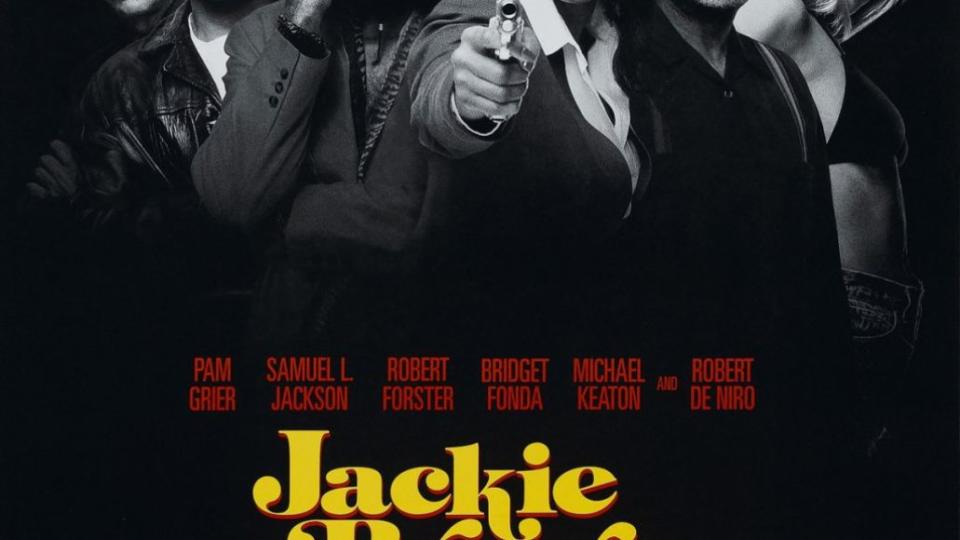
Runtime: 2 hr. 34 min.
Pitch: Jackie Brown was an adaptation of Elmore Leonard’s Rum Punch, the story of a down-and-out stewardess smuggling money for a low-level crook, a gun runner by name of Ordell Robie. However, when another one of Robie’s couriers gets busted, Robie’s operation starts to unravel thanks to the half-assed ambitions and execution of aging, arguably idiotic and self-centered criminals.
Cast: Pam Grier, Samuel L. Jackson, Robert Forster, Robert De Niro, Michael Keaton, Chris Tucker, and Bridget Fonda
T Gonna T: The classic Tarantino trunk shot re-appears. You know, that low-angle thing Tarantino loves to play with? However, the way the shot’s used as a prelude to a snake-like scene of double crossing is so pitch perfect and patiently Tarantino. This scene’s become the film’s calling card. That, and the line about AK-47’s…
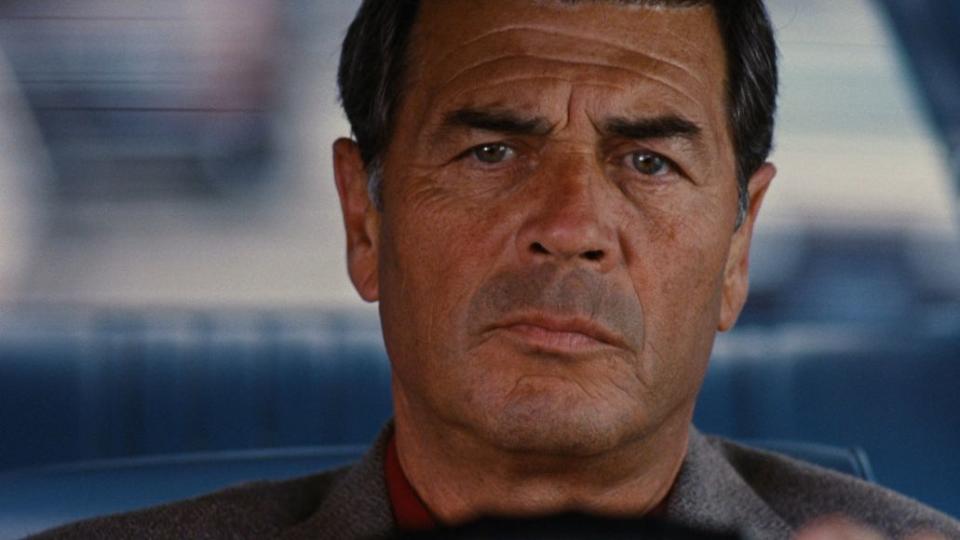
The Revival: Tarantino got two solid talents out of the woodwork for this one. Robert Forster of Medium Cool got an Oscar nod for his work as the level-headed bail bondsman Max Cherry. And Pam Grier, Coffy herself (one of Tarantino’s all-time favorites), nabbed the lead role. Both actors parlayed their work here into solid second lives for their careers. Meanwhile, no one ever heard from Bridget Fonda ever again this. At least that’s what it feels like, no?
The Master Himself: QT appeared as the electronic voice on Jackie’s answering machine. Subtle. However, you remember QT in the teaser?
Harvey the Hard-Ass. After Pulp Fiction’s hyper success, Tarantino didn’t want to top himself. He wanted to go “underneath it,” according to a 2003 interview with Peter Biskind in Vanity Fair. Jackie Brown would become his first script adaptation. Though, according to Biskind’s Down and Dirty Pictures, Tarantino was having some commitment issues in the mid-‘90s after he broke out, and then-head of Miramax (RIP) Harvey Weinstein was not a fan of the script’s first draft.
Weinstein balked at the length, allegedly wanting Tarantino to hide it. Keep in mind, this is a very anxious Tarantino coming off an undeniable epic of indie invention in 1994. Plus, you know … “Harvey Scissor-hands.” The end result is a two-hour and 34-minute blast of a caper, which showed people that Tarantino was a mindful inventor and director, and not just an over-nighter.
Spike v. Quentin. Ah, here was the beginning of Spike Lee and Quentin Tarantino’s very public feud over race and Tarantino’s use of the N-bomb. Here’s some quick context: It seemed like they were both cool with each other in 1996. QT cameoed in Lee’s forgotten comedy Girl 6 as a sleazy dude and thought he was doing the filmmaker a big favor.
In ’97, when Jackie Brown came out, Lee took great exception to Tarantino’s script having something like 38 n-word uses (primarily as slang by Samuel L. Jackson’s Robie character). Lee took his grievances to Variety in a column. Tarantino was supposedly very hurt and felt like he was just using language in appropriate context for the characters he was depicting.
The rage continues.
In 2012, Spike accused Tarantino of Blacksploitation with Django Unchained.
Just last month, Tarantino called Lee a “son of a bitch” in a Brazilian newspaper.
Guys, please, bury the hatchet. You’re both great. Jackson narrated both of your films this year! Can’t you see you’re both furiously gifted, punchy directors?
Anyway, their years of beef started with this film. Or maybe it was over Girl 6…

Analysis: The ‘90s were a fine time to adapt Elmore Leonard. Between this, Out of Sight, and Get Shorty, there was a serious glut of good Leonard adaptations. There was even a great failed show based on Maximum Bob. But what distinguished Jackie Brown was the Tarantino touch on Leonard’s capers, naturally. Pitched as an homage on Blacksploitation of the ’70s, Tarantino elevated Leonard’s shifty characterizations with his verve for delicious, protracted dialogue.
As a director, Tarantino’s always made a name for himself with swift, bold moves, and Jackie Brown has all the patience and nuance of a late-period film. It even has genuine wisdom to be found against the middle-aged filthiness of its cast of lost-cause criminals and screwups. And Brown was only Tarantino’s third feature. This is a film that’s not-so-secretively about older people who let weak roles and bad ideas get in their way, and everyone’s in a sort of childlike, wannabe-a-bad-boy stasis.
Jackie Brown is about regretful hoods for life. And incidentally, the film takes on a pleading quality from Tarantino — to not get stuck in roles and to really think about what he wanted to do and say with his work. Here’s Tarantino, not as a post-Pulp geek, but a genuine filmmaker expanding his emotional scope. Jackie Brown was an underrated attempt at caper that quietly reveals itself as a groovy meditation on schemers and dreamers. It’s the lost and muted masterpiece in Tarantino’s portfolio.
— B.G.
01. Pulp Fiction (1994)
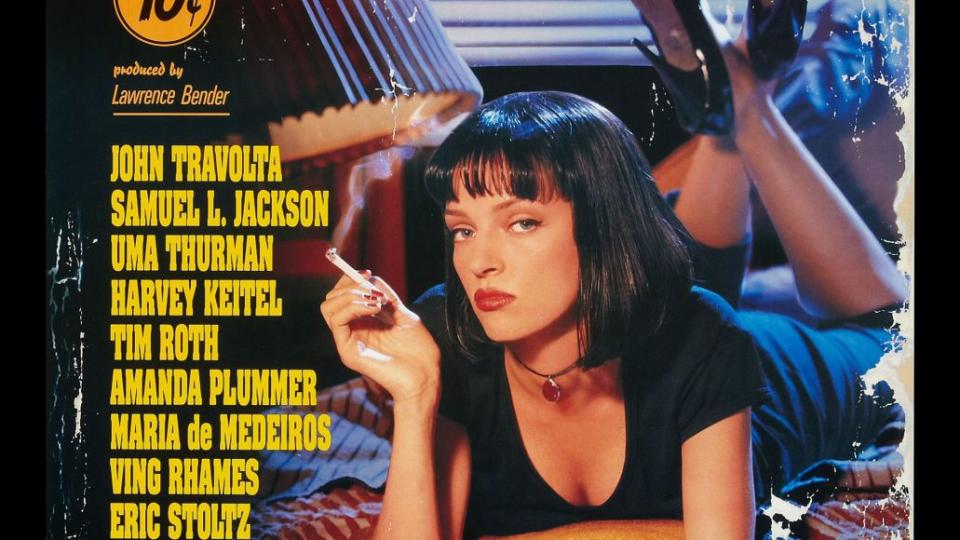
Runtime: 2 hr. 34 min.
Pitch: Two mob hitmen, a prize fighter, a gangster’s wife, and some low-level thieves collide over the course of four different stories, each inspired by the kind of stories you’d find in a moldy dimestore paperback.
Cast: John Travolta, Samuel L. Jackson, Uma Thurman, Bruce Willis, Tim Roth, Amanda Plummer, Ving Rhames, Harvey Keitel, and Christopher Walken
T Gonna T: Cue Chuck Berry’s “You Never Can Tell”, the song that turns Uma Thurman and John Travolta’s kaleidoscopic twist-off into something so much more than a Godardian musical break. The song’s jaunty twinkle serves the opposite purpose of Reservoir Dogs’ “Stuck in the Middle with You”; instead of serving as an ironic counterpoint to the onscreen action, “You Never Can Tell” gives the film a chance to let its hair down. As in Godard’s films, this musical sequence is a safe space, probably the only one in a film where everyone is (rightly) on edge at all times (howdy, Marvin!). It doesn’t hurt that Thurman based her dance moves on the Duchess from The Aristocats.
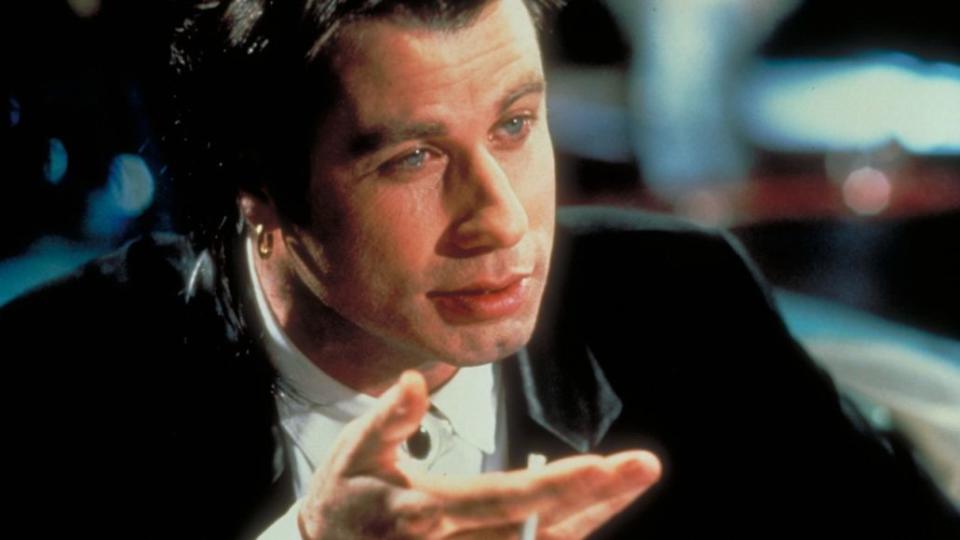
The Revival: Were it not for Pulp Fiction, John Travolta would still be making talking baby movies (all due respect to the Look Who’s Talking franchise). What Tarantino did for Travolta is essentially what he does for all the movies he rips off: remind everyone why we all used to love them so much. Tarantino is so clearly attuned to what made something work, what made it cool.
Travolta’s always been a tricky actor, though. Without the right molding, his hamminess can overwhelm. But Tarantino never forgot how good Travolta was under Brian De Palma’s direction in 1981’s Blow Out, especially in that film’s gutting final scene. He wanted that Travolta. He got it, too. As Vincent Vega, Travolta is charming, graceful, and haunted, if a touch stubborn (see: “a ‘please’ would be nice”). He even got a Best Actor nomination from the Academy. He hasn’t topped it since.
The Master Himself: Tarantino plays Jimmy, an associate of Harvey Keitel’s The Wolf. As in Reservoir Dogs, he exists mainly to heavily articulate his way through another foul-mouthed monologue. He also drops the n-word a lot, which I suppose is supposed to be okay because the character has a black wife? Let’s move on.
The Tarantino Cinematic Universe: Tarantino knows what it’s like to be a fanboy, so he seems to take great delight in referencing not just other films, but his own. Several of his films incorporate the made-up brands Big Kahuna Burger, Fruit Brute, and Red Apple cigarettes. There’s also the well-documented fact that Travolta’s Vincent Vega is the brother of Michael Madsen’s Vic Vega (aka Mr. Blonde from Reservoir Dogs). Tarantino’s Jimmy shares a last name with Reservoir Dogs’ Larry Dimmick, the same guy who talks about running jobs with a woman named Alabama, the name of Patricia Arquette’s character in True Romance, which Tarantino wrote but didn’t direct.
The same actress who is yanked out of a car by Steve Buscemi in Reservoir Dogs is shot in the leg by Marcellus Wallace in Pulp Fiction, prompting viewers to assume it’s the same unlucky lady. There’s even speculation that Samuel L. Jackson’s Kill Bill character, Rufus, is actually Pulp Fiction’s Jules, still wandering the Earth “like Caine from Kung Fu.” Is it all a little silly? Sure, but any fanboy will tell you sometimes those “what if” conversations are the most fun conversations. There’s a special place in heaven for filmmakers who give their fans so much kibble.
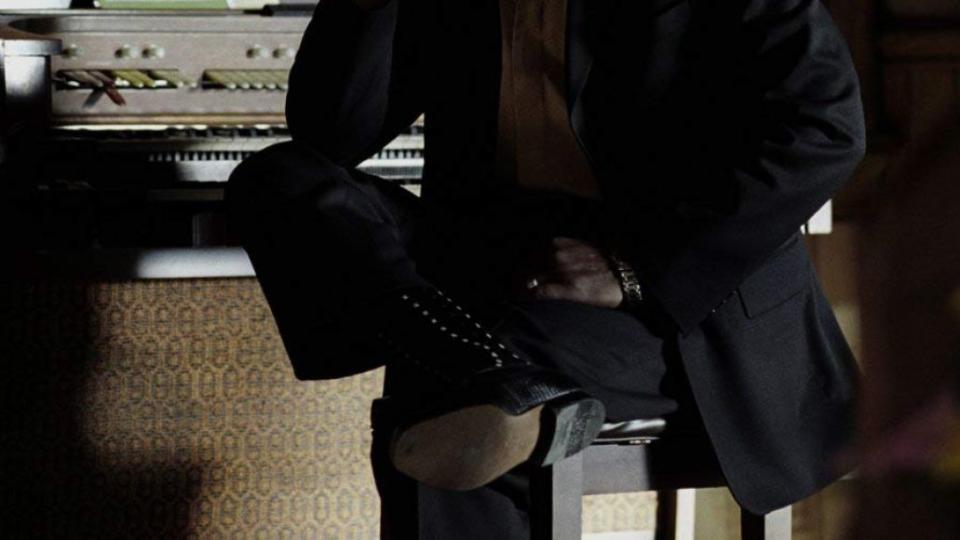
A Midnight Cab Ride: One of Pulp Fiction’s most curious scenes is the cab ride Butch takes with Esmarelda (Angela Jones), an exotic, primal woman who feels plucked from another film entirely. Her dreamlike countenance and talk of mortality isn’t the only indication that this scene might not exist within the film’s reality; take a closer look and you’ll notice that the background is rendered in black and white.
Furthermore, Tarantino makes no effort to hide the fact that the cab isn’t even moving – you can even hear Butch’s gloves plop on the ground when he tosses them out the window. Maybe it’s another Godard homage – surrealism emerging within otherwise realistic environments – or perhaps it’s a throwback to the existential milieu of Film Noir.
Or maybe it’s Brechtian, a conscious breaking of the fourth wall that serves to disengage the audience so they’ll take a moment to consider the artist’s intent. Whatever the case, Tarantino was inspired to write the scene after seeing Jones in a short film called Curdled. In any other film, this scene would be cut immediately, but the fact that Tarantino keeps it is part of the reason he’s such a fascinating filmmaker. Movies need texture. They need moments that don’t feel like the rest. It keeps things interesting. It makes art distinctive.
Analysis: Pulp Fiction is truly the film where Tarantino indulged his every cinematic whim. The result was such a particular kind of cool, a new kind of cultural currency. This is the film that made movie nerds feel like badasses again, as every cinematic trope they grew up on was being bundled in a way that felt urgent, relevant, and, well, hip. Pulp Fiction, and Tarantino as a filmmaker in general, matters because it caused the film snob cognoscenti to re-examine their relationship to genre film. Can pulp, crime, and horror be so maligned when it can look like this?
As with Reservoir Dogs, this is a movie that hinges not on story, but on presentation. Style, vision, and voice became a commodity again. That this pastiche of decades, genres, and film styles so thoroughly infiltrated the Academy in 1994 caused a seismic shift within Hollywood. With Pulp Fiction, Tarantino opened the door to mainstream experimentation – the three-act structure can be massaged, actors can surprise, violence can be funny, and audiences can be trusted to go along with it.
— R.C.
A Definitive Ranking of Quentin Tarantino’s Films
Consequence Staff
Popular Posts
Former Van Halen Bassist Michael Anthony Forms New Band with Members of Bon Jovi, Aerosmith
Virginia Tech Students Sing Metallica's "Enter Sandman" After NCAA Bans It from Being Played: Watch
Kanye West Says He's No Longer An Anti-Semite After Watching Jonah Hill in 21 Jump Street
Robert Fripp and Toyah Nearly Bare All with Cover of J. Geils Band's "Centerfold": Watch
